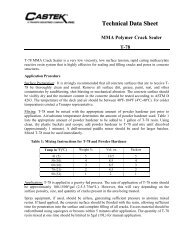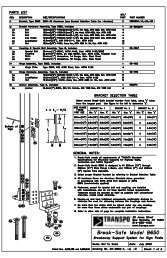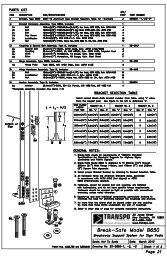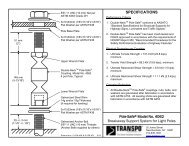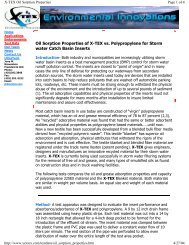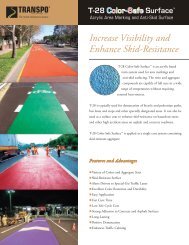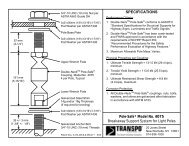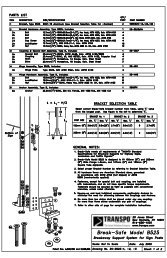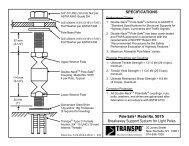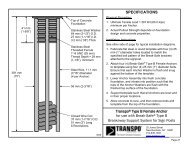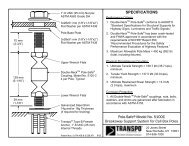Bridge Preservation Action Team - Transpo Industries, Inc.
Bridge Preservation Action Team - Transpo Industries, Inc.
Bridge Preservation Action Team - Transpo Industries, Inc.
Create successful ePaper yourself
Turn your PDF publications into a flip-book with our unique Google optimized e-Paper software.
May-June 2011The official publication of the American Road & <strong>Transpo</strong>rtation Builders Associationwww.artba.orgARTBA <strong>Action</strong> <strong>Team</strong><strong>Action</strong> <strong>Team</strong> Provides Voiceon <strong>Bridge</strong> <strong>Preservation</strong>As we look to the future of ournation’s infrastructure, it hasbecome obvious that thereneeds to be a fundamental change inour approach to bridge maintenance.Until recently, this involved reactivemeasures rather than proactive ones.It is clear that this practice, along withless than adequate funding, has led tothe current situation where an overwhelmingnumber of our bridges arein need of major attention. We needcollaboration and leadership to addressthe preservation needs in thebridge sector.To that end, we recentlymerged the former <strong>Bridge</strong> <strong>Preservation</strong>Association (BPA) with ART-BA’S <strong>Bridge</strong> Policy and PromotionCouncil (BPPC). This new actionteam under the BPPC is called the“<strong>Bridge</strong> <strong>Preservation</strong> <strong>Action</strong> <strong>Team</strong>”(BPAT). The mission of the BPATwill focus on bridge preservation andmaintenance practices, procedures,products and technologies that helpstakeholders enhance bridge performance,extend their service life andincrease public safety.What Type of Issues Need toBe Addressed?<strong>Bridge</strong> preservation centers on activitiesperformed on bridge elementsor components that aim to prevent,delay, or reduce deterioration. Theseactivities do not entail structural oroperational improvements of an existingbridge asset beyond its originallydesigned capacity.Currently, the nation’s bridges areinspected bi-annually in an effort toclassify conditions and assign each onea corresponding rating. Unfortunately,these inspections do not always resultin maintenance actions, and when actionsare taken, they are more oftenthan not preservation based.The Reality ofAging InfrastructureAs an example, the detrimentaleffect of corrosion caused by the useof deicing salts and the environmentcan be addressed with relatively minimalcost if action is initiated soon afterit is detected. When corrosion is leftuntreated, it will progress at an exponentialrate and can lead to partial orcomplete failure. Repairs or replacementon failed components or structurescan cost as much as 10 timesthat of a scheduled maintenance orpreservation procedure.Furthermore, the aging infrastructurerequires increased maintenance.In the past, owners were not able toidentify cancerous corrosion relateddamage that lead to expensive repairsor replacement. However, there aremany non-destructive tests (NDT)available to identify cancerous natureof corrosion.The Future of <strong>Bridge</strong>sBy not making a concerted effortto preserve the condition of this nation’sbridges, the number in poor orcritical condition has and will continueto grow in the future. Many bridges inBy Michael StenkoBy Siva Venugopalan“Currently, our country’sbridges are inspected biannuallyin an effort to classifybridge conditions andassign each one a correspondingrating. Unfortunately,these inspections donot always result in maintenanceactions, and whenactions are taken, they aremore often than not preservationbased.”the nation’s inventory are in the needof extensive and costly rehabilitationin as little as half of their original designlife. By definition “preservation” is atreatment or practice that is designedto extend the structure’s service life.In recent years, the Federal HighwayAdministration (FHWA), AmericanAssociation of State Highway and<strong>Transpo</strong>rtationBuilder May-June 201112 www.artba.org
<strong>Bridge</strong> preservation focuses on activities performed on bridge elements or components that aim to prevent, delay, or reduce deterioration. These activitiesdo not entail structural or operational improvements of an existing bridge asset beyond its originally designed capacity.<strong>Transpo</strong>rtation Officials (AASHTO)and other groups have begun to focustheir attention on this issue in order togain a greater understanding as to theshort and long-term benefits of effectivebridge preservation programs.The BPAT AgendaThe BPAT’s plan of work will addressthe industry’s perspective onbridge preservation. Activities willinclude the formulation of nationalpolicies on bridge preservation, creationof products including, best practiceguides and educational materials,and development of content for theInternational <strong>Bridge</strong> Conference andTransOvation. BPAT representativeswill also continue to serve asthe private-sector technical liaisons tothe <strong>Bridge</strong> <strong>Preservation</strong> Expert TaskGroup (BPETG), organized by FHWA,and the <strong>Transpo</strong>rtation System <strong>Preservation</strong>Technical Services Program(TSP-2), sponsored by AASHTO.The BPAT hopes to attract memberswith knowledge of the bridge industryand bridge preservation as wellas those with unique or specific areasof expertise. Industry experts will beasked to contribute to the creation ofeducational and informational tools intheir specific areas of knowledge. TheBPAT will be working to establish subcommitteesand work plans for variousbridge components that wouldqualify for preservation.Existing BPA members will becomeARTBA members. For more information,or to get involved with the BPAT,visit www.artbabridgecouncil.org orcontact ARTBA’s Vice President ofMember Services Allison Wenograd atawenograd@artba.org. Michael Stenko is the president of <strong>Transpo</strong><strong>Industries</strong>, <strong>Inc</strong>., and chair of the BPAT. Hecan be reached at mstenko@transpo.com.“By not making a concerted effort to preserve the conditionof this nation’s bridges, the number of bridges in pooror critical condition has and will continue to grow in thefuture. Many bridges in the nation’s inventory are in theneed of extensive and costly rehabilitation...”Siva Venugopalan is principal at SivaCorrosion Services, <strong>Inc</strong>., and co-chairof the BPAT. He can be reached atsiva@sivacorrosion.com.www.artba.org<strong>Transpo</strong>rtationBuilder May-June 2011 13



